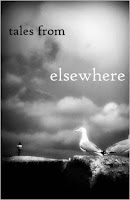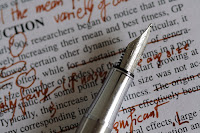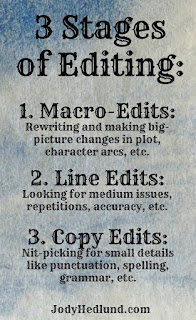Editing With Sue McDonagh
 In week two of my series on editing, I am very pleased to welcome another writing friend, Sue McDonagh, to the blog. I met Sue when we turned up at a new writers' circle called WriteGroup! in Cowbridge. We hit it off straightaway; we were both attempting to write a novel and we were going to try NaNoWriMo for the first time. That November in 2014, we became NaNo buddies and encouraged each other to keep going and achieve the target of writing 50,000 words+ in a month. On January 1st 2016, we achieved another first. We've both been fortunate in gaining a place on the New Writers' Scheme and we are both editing a novel for the first time.
In week two of my series on editing, I am very pleased to welcome another writing friend, Sue McDonagh, to the blog. I met Sue when we turned up at a new writers' circle called WriteGroup! in Cowbridge. We hit it off straightaway; we were both attempting to write a novel and we were going to try NaNoWriMo for the first time. That November in 2014, we became NaNo buddies and encouraged each other to keep going and achieve the target of writing 50,000 words+ in a month. On January 1st 2016, we achieved another first. We've both been fortunate in gaining a place on the New Writers' Scheme and we are both editing a novel for the first time.
Please tell us about this first experience of editing a novel, Sue.
Although I’ve spent my life ‘writing about things’, this is my first
attempt at a full length novel. It’s in the romantic, chick-lit genre, light-hearted yet thought-provoking in turn.
After incubating
the idea for a novel for a couple of years without the faintest idea how to start
it, I discovered NanoWriMo, in which one commits to writing 50,000 words in a
month. Fifty thousand
words! I couldn’t imagine writing that much. No-one was more surprised than me
when I achieved that target - and carried on writing, every single night.
 |
| Yes, this is Sue! |
The novel grew and
grew and reached 60,000 words at which point my writing friend, Jan Baynham,
offered to read it for me. I’d felt quite
proud of it until the moment I e-mailed it over. Overnight, the scales dropped
from my eyes and I lay awake thinking how truly amateurish it was, and how much
better it could be. I sent a message
saying: "Please don’t read it! It’s terrible! I can do better!” Jan, bless her, said she’d actually rather enjoyed what she’d read,
but I’d already re-read my humble offerings as if I was using someone else's
eyes. My heroine irritated me, and I’d gone off the story-line.
I guess that was my
very first experience of editing. In my
other life, I’m an artist, and I’m familiar with the idea that’s it’s sometimes
necessary to destroy your art in order to create something better. It can be a
scary process, and not for the faint-hearted. Every time I do it, I learn.
Occasionally I learn that I should have left it alone in the first place - but
more often than not, I surprise myself and feel that artistically, I’ve moved
on. With that in mind, I re-wrote almost
all of those 60,000 words and liked it a whole lot better. I worked on the character bibles for my cast,
and I read everything I could lay my hands on about arcs and three act scenes
and creating tensions and conflicts and dramas.
Two friends were
‘beta-reading’ my Work in Progress as fast as I wrote it. I felt like Scheherezade, passing my chapters
into their eager hands on a daily basis. They were short chapters. More on that later.
Then I went into hospital for a hip replacement. My brain turned to
mush after the General Anaesthetic, so it was a few weeks before I looked at my
novel again. When I did, I was
horrified. I e-mailed one of my two
friends.
“I must
congratulate you on your tenacity in reading this tripe,” I said.
I could
hardly credit my own arrogance in sharing it publicly - who did I think I was?
She replied, “It’s really not that bad, But maybe you could…” and she sent a short
list of encouraging and honest points which had me reaching for my laptop and
opening a fresh document. Once again, I reviewed and re-wrote, and the novel thundered towards
its conclusion. With the end in sight, I
wrote more and more slowly, tying up loose ends, trying to maintain the tension
I’d created, explaining by showing and not telling - and then I stalled.
I realised that I
had a beginning, and an end, and not so much the notorious soggy middle, as
hardly any middle at all. If you drew my
story line as a graph, it would look like the sort of mountain a child draws.
Like a cone. Up one side and down the other.
And somehow, not only did all the stuff I was trying to cram into the
end need to go into the middle, it was also incoherent and muddled. A major re-write was called for. Far from feeling depressed that I had to carve up my novel, I felt
quite excited and set to work. This time
I read everything aloud, which helped me to recognise where I’d gone wrong.
Hours and hours of jiggling documents around and saving eternally to DropBox -
then worrying that I’d saved over a chapter and lost it - and finally, I got to
the denouement. It was very exciting.
I’ve finished, I
thought, as I typed, 'The End'. I began to tidy it up with a view to submitting
it to publishers and agents. They need
the first three chapters, I discovered.
My chapters were skimpy, insubstantial things. More like scenes,
really. So they had to be
re-assembled. It was beginning to look,
I hoped, like a proper book at last. But it was still not, quite,
right…
 It was 103,300 words, this manuscript. It needed to go on a Word Diet. I combed out flabby phrasing, and typos, and
lost 800 words with reasonable ease. So that’s the grammatical errors attended to - now the editing is
harsher, and closer to my heart. I’m beginning to
understand the phrase ‘kill your darlings’. I’ve removed lines where I thought
I was being funny - and now realise they’re misplaced humour - put in the mouth
of the wrong recipient.
It was 103,300 words, this manuscript. It needed to go on a Word Diet. I combed out flabby phrasing, and typos, and
lost 800 words with reasonable ease. So that’s the grammatical errors attended to - now the editing is
harsher, and closer to my heart. I’m beginning to
understand the phrase ‘kill your darlings’. I’ve removed lines where I thought
I was being funny - and now realise they’re misplaced humour - put in the mouth
of the wrong recipient.
I’m keeping a ‘cuttings’ file, where all these sad cast-offs live,
and maybe they will see the light in some-thing else, who knows.
Several people now
have read my WiP in its entirety; half read it within days and told me it was
gripping and they couldn’t put it down.
I couldn’t ask for better feedback! I was delighted…until I squeezed
feedback out of the quiet ones, who told me: “Too much technical stuff” and “I don’t see what was wrong with
their relationship” etc, sending me back to the drawing board. I’ve fixed the second observation - but I’m not sure what to do
about the first one, and I think I’m running the risk of hacking it up and
spoiling it. It’s still too wordy by at
least two thousand words, but it needs a lighter touch now than my swingeing
cursor. Too easy to highlight entire paragraphs and press ‘Delete’!
My next step is to send it for assessment to the RNA. I’m sure there will be a further set of
observations to attend to.
Shall I meet you here for the next editing session? Mine’s a black coffee. Oh, and Victoria Sponge please, if you’re buying…
A very big thank you for sharing the ups and downs of your first experience of editing in such an honest way, Sue. I can certainly relate to the feeling that my writing is amateurish and I've had many crises of confidence. You're a lot further along with the editing than me and I haven't got as far as getting feedback from Beta readers yet. I think that the coffee and cake session can be arranged, though!
To find out more about Sue, please follow her on her Face Book page:
and on Twitter:
Thank you for reading. Can you relate to any of Sue's experiences when you edited your first novel? Did you use story arcs to help you see where there needed to be major structural changes? Please share your experiences with us. Thanks!
You may also follow me on Twitter @JanBayLit and on my Jan Baynham Writer Facebook page.
 Here is the third in my series of guest blogs about editing and, this week, I am particularly pleased to welcome fellow writer, Susanna Bavin. Sue lives in a beautiful part of the world, Llandudno in North Wales. As well as writing novels, she presents a thought-provoking blog each week and I'm sure many of you will have received a beautiful picture of a rose or of her beloved home town as a thank you when you leave a comment. I first 'met' Sue during NaNoWriMo 2014 when she became one of my buddies for the month. I soon realised that she was very supportive and through her encouragement, I manage to reach the 50,000 + word count. Since then, we have remained in touch and are hoping to meet up for the first time at the RNA conference in July.
Here is the third in my series of guest blogs about editing and, this week, I am particularly pleased to welcome fellow writer, Susanna Bavin. Sue lives in a beautiful part of the world, Llandudno in North Wales. As well as writing novels, she presents a thought-provoking blog each week and I'm sure many of you will have received a beautiful picture of a rose or of her beloved home town as a thank you when you leave a comment. I first 'met' Sue during NaNoWriMo 2014 when she became one of my buddies for the month. I soon realised that she was very supportive and through her encouragement, I manage to reach the 50,000 + word count. Since then, we have remained in touch and are hoping to meet up for the first time at the RNA conference in July. 5. If you have written a multi-viewpoint novel, is it obvious from the opening to each scene whose POV it is, without needing to see the name? Each character's 'voice' should be distinct.
5. If you have written a multi-viewpoint novel, is it obvious from the opening to each scene whose POV it is, without needing to see the name? Each character's 'voice' should be distinct.






















